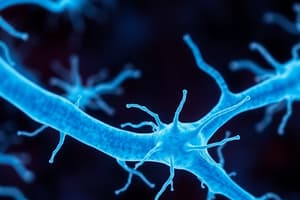Podcast
Questions and Answers
Which part of a neuron receives signals from other neurons?
Which part of a neuron receives signals from other neurons?
- Axon
- Dendrites (correct)
- Cell body
- Terminal buttons
What is the main function of the Central Nervous System (CNS)?
What is the main function of the Central Nervous System (CNS)?
- To regulate body temperature
- To transmit signals to muscles and glands
- To produce hormones
- To integrate and process information (correct)
What is the gap between neurons where chemical signals are transmitted?
What is the gap between neurons where chemical signals are transmitted?
- Terminal button
- Dendrite
- Synapse (correct)
- Axon
Which nervous system function is responsible for detecting internal and external stimuli?
Which nervous system function is responsible for detecting internal and external stimuli?
What is the function of the Autonomic Nervous System?
What is the function of the Autonomic Nervous System?
What is the function of the Somatic Nervous System?
What is the function of the Somatic Nervous System?
What is the blood-brain barrier?
What is the blood-brain barrier?
What is the term for the modification of synaptic connections through experience?
What is the term for the modification of synaptic connections through experience?
What is the term for the basic units of the nervous system?
What is the term for the basic units of the nervous system?
What is the function of terminal buttons?
What is the function of terminal buttons?
Flashcards are hidden until you start studying
Study Notes
Nervous System
Overview
- The nervous system is a complex system that allows the body to respond to internal and external stimuli
- It consists of two main parts: the Central Nervous System (CNS) and the Peripheral Nervous System (PNS)
Central Nervous System (CNS)
- Consists of the brain and spinal cord
- Responsible for:
- Integrating and processing information
- Controlling voluntary movements
- Regulating body functions (e.g. heart rate, blood pressure)
- Protected by the blood-brain barrier, a selective barrier that allows certain substances to pass through
Peripheral Nervous System (PNS)
- Consists of nerves that connect the CNS to the rest of the body
- Divided into two subsystems:
- Somatic Nervous System: controls voluntary movements (e.g. movement of muscles)
- Autonomic Nervous System: controls involuntary movements (e.g. heart rate, digestion)
Neurons
- Basic units of the nervous system
- Consist of:
- Dendrites: receive signals from other neurons
- Cell body: contains the nucleus and maintains the cell
- Axon: carries signals away from the cell body
- Terminal buttons: release neurotransmitters to transmit signals
Synapses
- Gaps between neurons where chemical signals are transmitted
- Neurotransmitters released from terminal buttons bind to receptors on adjacent neurons
- Strength of synaptic connections can be modified through experience (synaptic plasticity)
Nervous System Functions
- Sensation: detection of internal and external stimuli
- Perception: interpretation of sensory information
- Movement: voluntary and involuntary movements
- Regulation: control of body functions (e.g. heart rate, blood pressure)
- Control: coordination of movements and responses
Nervous System Overview
- Complex system allowing body to respond to internal and external stimuli
- Consists of two main parts: Central Nervous System (CNS) and Peripheral Nervous System (PNS)
Central Nervous System (CNS)
- Comprises brain and spinal cord
- Responsible for integrating and processing information, controlling voluntary movements, and regulating body functions like heart rate and blood pressure
- Protected by blood-brain barrier, a selective barrier allowing certain substances to pass through
Peripheral Nervous System (PNS)
- Consists of nerves connecting CNS to rest of body
- Divided into Somatic Nervous System, controlling voluntary movements like muscle movement, and Autonomic Nervous System, controlling involuntary movements like heart rate and digestion
Neuron Structure and Function
- Basic units of nervous system consisting of dendrites, cell body, axon, and terminal buttons
- Dendrites receive signals from other neurons
- Cell body contains nucleus and maintains cell
- Axon carries signals away from cell body
- Terminal buttons release neurotransmitters to transmit signals
Synaptic Transmission
- Chemical signals transmitted across gaps between neurons (synapses)
- Neurotransmitters released from terminal buttons bind to receptors on adjacent neurons
- Strength of synaptic connections can be modified through experience (synaptic plasticity)
Nervous System Functions
- Sensation: detection of internal and external stimuli
- Perception: interpretation of sensory information
- Movement: voluntary and involuntary movements
- Regulation: control of body functions like heart rate and blood pressure
- Control: coordination of movements and responses
Studying That Suits You
Use AI to generate personalized quizzes and flashcards to suit your learning preferences.




